Metal Ceilings Market Research, 2032
The global metal ceilings market size was valued at $2.4 billion in 2020, and is projected to reach $4.3 billion by 2032, growing at a CAGR of 4.8% from 2023 to 2032. A metal ceiling refers to a type of ceiling system constructed primarily from metal. These ceilings are commonly used in commercial settings. Metal ceilings offer durability, fire resistance, and aesthetic versatility, with options available in different finishes, patterns, and designs. They provide a modern and stylish appearance while also offering practical benefits such as easy maintenance and excellent acoustical performance.
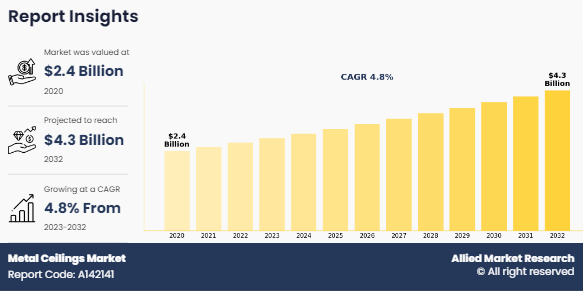
Report Key Highlighters
The Metal Ceilings market analysis studies more than 23 countries. The analysis includes a country-by-country breakdown analysis in terms of value ($million) available from 2022 to 2032.
The Metal Ceilings Market statistics research combined high-quality data, professional opinion, and research, with significant independent opinion. The research methodology aims to provide a balanced view of the global market, and help stakeholders make educated decisions to achieve ambitious growth objectives.
The research reviewed more than 3,700 product catalogs, annual reports, industry descriptions, and other comparable resources from leading industry players to gain a better understanding of the market.
The Metal Ceilings market share is marginally fragmented, with players such as Armstrong World Industries, Hunter Douglas, SAS International, ROCKWOOL Group (Rockfon), Knauf (USG Corporation), Saint-Gobain (CertainTeed), OWA Ceiling Systems, Gage Corporation International, Decoustics, and Tincpro Metal Industries. Major strategies such as product Launch, partnerships, expansion, and other strategies of players operating in the market are tracked and monitored.
Market dynamics
The Metal Ceilings market is witnessing a surge with a greater increase of commercial spaces, growing demand for sustainable improvement, and high aesthetic appeal of metal ceilings.
The construction sector internationally, especially in Asia-Pacific is developing at a quick rate. This is essentially due to various government-sponsored projects in China, and India. For instance, in October 2021, the Dubai and Indian governments agreed to develop infrastructures including industrial complexes, multipurpose towers, logistics facilities, a medical university, and a specialised health center in the state of Jammu and Kashmir, India. In addition, China is going to construct 10 new airports by the year 2035, eventually driving the demand for Metal Ceilings. Moreover, in January 2024, Poland started construction of an airport Centralny Port Komunikacyjny (CPK)‐™ at a cost of more than $8 billion. Furthermore, by 2040, the worldwide population is anticipated to rise by two billion, with the urban population developing by over 40%. Population boom and rapid urbanization are predicted to affect the development of residential and industrial buildings. This provides opportunities for the implementation of Metal Ceilings thereby positively affecting the metal ceilings market growth.
The metal ceilings market opportunity extensively lies in commercial buildings owing to their remarkable attributes and suitability for various applications. Renowned for their durability, metal ceilings offer exceptional resistance to wear and tear, making them ideal for high-traffic areas within commercial settings. Moreover, their superior fire resistance properties contribute significantly to the safety of occupants by containing fires and preventing their spread. Easy maintenance is another notable advantage, as metal ceilings require minimal upkeep compared to traditional materials like gypsum or wood, enhancing the overall efficiency of building management. Additionally, metal ceilings can be engineered to provide excellent acoustical performance, ensuring a comfortable and productive environment for occupants. With a wide range of design options available, including various finishes, patterns, and perforations, metal ceilings offer unparalleled design flexibility, enabling designers to create visually striking interiors that reflect the desired aesthetic and brand identity of the commercial space.
Furthermore, many new commercial buildings such as offices, warehouses, and others are being constructed across the world, which eventually have a positive impact on the metal ceilings market growth. For example, in Q4 of 2024, a project involving the construction of 12,400m2 three office buildings with five, six, and seven-stories respectively in the Central Jutland, Denmark. Similarly, in North America, office buildings are being constructed. For example, construction work on 1900 Lawrence Street Office Tower, a $400 million building project commenced in Q2 2022 and is expected to finish in Q4 2024. The rising number of commercial spaces is fueling the demand for metal ceilings as businesses seek durable, versatile, and aesthetically appealing solutions for their interior environments. With the expansion of industries such as retail, hospitality, healthcare, education, and corporate offices, there is a growing need for high-performance ceiling systems that can withstand the rigors of commercial use while enhancing the overall ambiance of the space. Metal ceilings offer numerous advantages that cater to the specific requirements of commercial applications, including durability, fire resistance, easy maintenance, design flexibility, and sustainable attributes. As the commercial sector continues to grow and evolve, the demand for metal ceilings is expected to rise, driven by the desire to create functional, visually appealing, and sustainable environments that support productivity, well-being, and brand identity.
However, fluctuating prices of metal negatively effect the profitability of the manufacturers. Thus, this fluctuation of raw materials is expected to restrain the growth of metal ceilings market. For instance, the price of metal reduced by $79.8/metric tonne or about 14.51% in China in the start of 2024. Similarly, in April 2024, the futures of metal fell to about $466.2/metric tonne in March 2020. In addition, aluminum prices surged to $2,450 per tonne in April 2024, the highest in 14 months. This was due to a rally for other base metals, pressure on the dollar, supply concerns, and some traction in demand from China.
Moreover, due to global warming countries across the world are shifting towards sustainability across industries including the construction sector. metal ceiling is known for enhancing energy performance by providing thermal insulation which eventually helps in reducing the electricity bill of the building. Thus, an increase in the construction of green buildings is expected to provide lucrative growth opportunities to the metal ceilings market.
The metal ceilings market has witnessed various obstructions in its regular operations due to the COVID-19 pandemic and inflation. Earlier, the global lockdowns resulted in reduced construction and industrial activities, eventually leading to reduced demand for metal ceiling from the construction and industrial sectors. However, COVID-19 has subsided, and the major manufacturers in 2023 have been performing well. Contrarily, the rise in global inflation is a new major obstructing factor for the entire industry. The inflation, which is a direct result of the Ukraine-Russia war and few long-term impacts of the coronavirus pandemic, has introduced volatility in the prices of raw materials used for construction which is a major end-user sector of metal ceiling. In addition, inflation is expected to worsen in the coming years, as the possibility of the ending of the war between Ukraine and Russia is less. However, a peace agreement between Ukraine and Russia can be devised, with the continued talks between different countries, which is expected to end the war between them and reduce global inflation.
Segmental Overview
The Metal Ceilings market is segmented on the basis of metal type, application end user, and region. By metal type, the market is categorized into steel, aluminum, and others. On the basis of application, it is bifurcated into interior and exterior. As per the application, the market is divided into commercial, education, trasport, retail, healthcare, and others. Region wise, the market is analyzed across North America, Europe, Asia-Pacific, Latin America, and Middle East & Africa.
By type, the metal ceilings market is divided into steel, aluminum, and others. Each kind of metal has different characteristics and benefits, catering to different applications and preferences in the market. Galvanized iron ceilings are recognized for its corrosion resistance and affordability, making it a popular option for industrial and outdoor packages wherein robustness is vital. Steel ceilings, alternatively, are demanded due to its, versatility, and aesthetic appeal. Steel ceilings are available in various finishes and designs, providing architects and designers the ability to create custom solutions that complement any interior design. Aluminum ceilings are light-weight, easy to install, and extraordinarily long lasting, making them best for both commercial and industrial settings. Aluminum ceilings also provide high corrosion resistance and can be finished with numerous coatings to decorate their appearance and overall performance. Overall, the supply of various kinds of metal ceilings allows customers to select the alternative that best fits their custom requirements in terms of sturdiness, aesthetics, and budget.
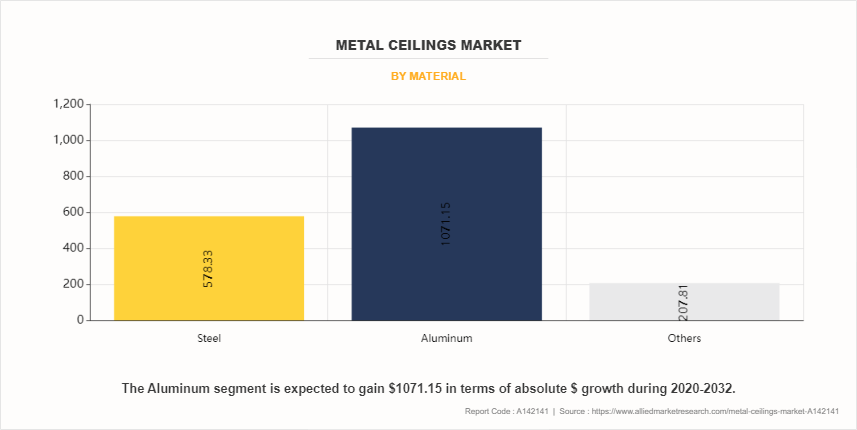
By application, the metal ceilings market is bifurcated into interior and exterior. Interior metal ceilings are used to enhance the visual appeal and functionality of interior spaces in various settings such as commercial buildings, offices, and other properties. Exterior metal ceilings are designed to withstand harsh environmental conditions and provide protection against weather elements in outdoor applications such as building facades and covered walkways. Overall, the bifurcation of the market reflects the diverse range of environments and requirements for which metal ceiling systems are utilized.
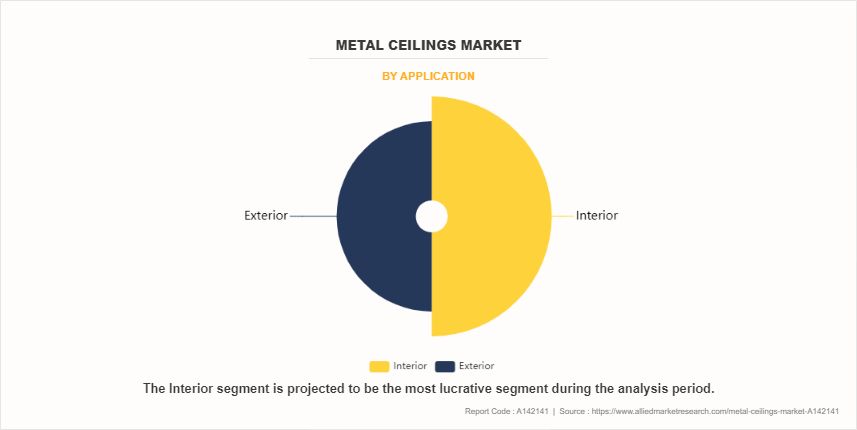
By end user, the metal ceilings market is categorized into commercial, education, transport, retail, healthcare, and others. Commercial spaces such as offices, hotels, and shopping centers often utilize metal ceilings for their durability, aesthetic appeal, and acoustic performance, enhancing the overall ambiance and functionality of these environments. In the education sector, metal ceilings are commonly found in schools, colleges, and universities, providing a conducive learning environment with features like acoustic comfort and thermal insulation. Transportation facilities like airports and train stations also benefit from metal ceilings, which offer durability, fire resistance, and passenger comfort. Retail spaces use metal ceilings to create visually appealing interiors that align with brand identity and optimize lighting distribution. In healthcare settings, such as hospitals and clinics, metal ceilings contribute to hygiene and infection control while providing acoustic comfort for patients.
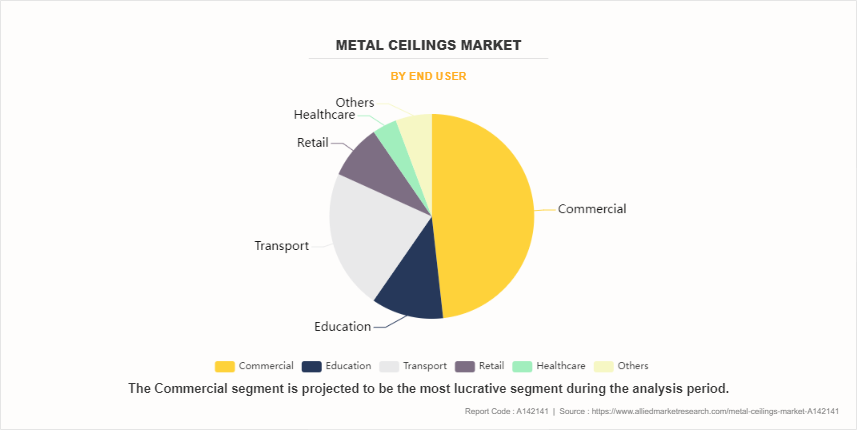
By region, the market is analyzed across North America, Europe, Asia-Pacific, and LAMEA. In 2020, Asia-Pacific had the highest market share and is anticipated to secure the leading position during the forecast period. The Asia-Pacific region presents many growth opportunities to the major players in the Metal Ceilings market, owing to rapid urbanization, and population growth in the countries such as India, South Korea, Japan, and China. For instance, China‐™s urban population is expected to rise to 72% in 2030 from just 64% in 2021. In India, the industrial sector is anticipated to witness a rapid surge owing to increasing urbanization, rising economy, digitalization, growth in the IT sector, and easy foreign direct investment norms. Moreover, countries in the Middle East such as. UAE, Saudi Arabia, and Qatar are the major construction market. This provides growth opportunities to the Metal Ceilings market in the region. Furthermore, in developed countries such as the U.S., Canada, Australia, and countries in Europe the rising tourism drives demand for highly appealing hotels, and resorts; thereby increasing the opportunities for implementing Metal Ceilings. According to a report by the World Travel & Tourism Council (WTTC), in 2019, the total contribution of tourism to GDP was 10.6%; however, after a steep decline in 2020, its contribution to GDP climbed a positive 58.5% in 2021. In addition, public infrastructure such as airports, bus stops, railway stations, and other that make significant use of metal ceiling is also anticipated to positively influence the market growth.
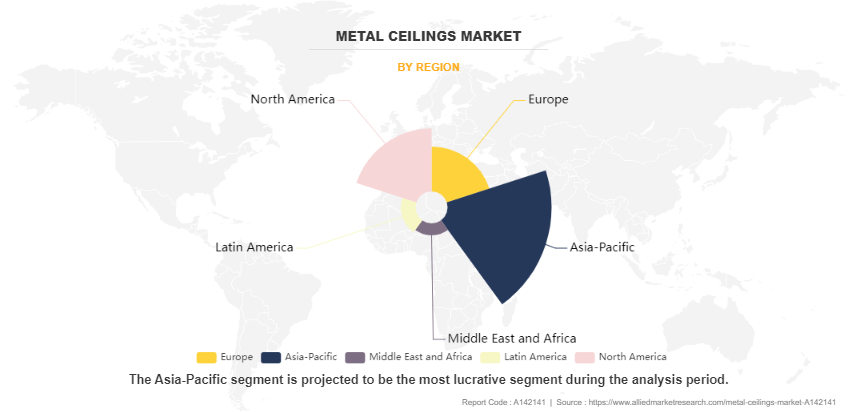
Competition Analysis
Competitive analysis and profiles of the major players in the Metal Ceilings market, such Armstrong World Industries, Hunter Douglas, SAS International, ROCKWOOL Group (Rockfon), Knauf (USG Corporation), Saint-Gobain (CertainTeed), OWA Ceiling Systems, Gage Corporation International, Decoustics, and Tincpro Metal Industries, are provided in the report. Major players have adopted product launch and acquisition as key developmental strategies to improve the product portfolio of the market.
Recent Development in the Metal Ceilings Market
- In November 2023, OWA UK introduces the System S 80 demountable metal ceiling a stylish solution for concealing M&E installations while enhancing sound absorption. This customizable product offers versatility in sizes, shapes, and colors, with options for various material finishes. Its low-profile design and hidden hanging system make it ideal for open soffit interiors, providing easy access for maintenance. The System S 80's full metal construction ensures durability, making it suitable for a range of commercial applications.
Key Benefits for Stakeholders
- The report provides an extensive analysis of the current and emerging Metal Ceilings market trends and dynamics.
- In-depth market analysis is conducted by constructing market estimations for the key market segments between 2020 and 2032.
- Extensive analysis of the Metal Ceilings market is conducted by following key product positioning and monitoring of the top competitors within the market framework.
- A comprehensive analysis of all regions is provided to determine the prevailing opportunities.
- The Metal Ceilings market forecast analysis from 2023 to 2032 is included in the report.
- The key market players within Metal Ceilings market are profiled in this report and their strategies are analyzed thoroughly, which help understand the competitive outlook of the Metal Ceilings industry.
Metal Ceilings Market Report Highlights
| Aspects | Details |
| Market Size By 2032 | USD 4.3 billion |
| Growth Rate | CAGR of 4.8% |
| Forecast period | 2020 - 2032 |
| Report Pages | 191 |
| By Material |
|
| By Application |
|
| By End User |
|
| By Region |
|
| Key Market Players | Knauf, Armstrong World Industries, Inc., Saint-Gobain, Hunter Douglas AG, Gage Corporation International, SAS International, OWA Ceiling Systems, Rockwool group, Tincpro Metal Industries, Decoustics |
Analyst Review
The metal ceilings market encompasses a diverse industry involved in the production, distribution, and installation of metal ceiling systems primarily used in non-residential buildings. These systems, made from various metals like aluminum, steel, copper, and tin, serve as architectural elements that provide both functional benefits and aesthetic appeal to commercial, industrial, institutional, and hospitality spaces.
Consumer preferences in the metal ceilings market are influenced by several factors. There is a growing demand for customized and aesthetically pleasing ceiling designs that reflect the brand identity and character of commercial spaces. Moreover, an increasing emphasis on indoor environmental quality has driven the adoption of metal ceilings with acoustic and thermal performance enhancements, contributing to occupant comfort and productivity.
For businesses operating in the metal ceilings market, there are numerous opportunities for growth and innovation. Expansion into emerging markets with high construction activity presents avenues for market penetration and diversification. Collaborating with architects, designers, and building owners to develop innovative metal ceiling solutions tailored to specific project requirements is key to meeting customer needs and gaining a competitive edge.
Investment in research and development to innovate new metal ceiling technologies and materials is essential for staying ahead in the market. Furthermore, offering value-added services such as design consultation, installation support, and post-sale maintenance enhances customer satisfaction and fosters long-term relationships.
Rising urbanization, increasing number of working class population, and large investments in infrastructure development across the world are driving the market growth.
The latest version of the Metal ceiling market report can be obtained on demand from the website.
The Metal ceiling market size was valued at $2.4 billion in 2020.
The Metal ceiling market size is estimated to reach $4.3 billion by 2032, exhibiting a CAGR of 4.8% from 2023 to 2032.
The forecast period considered for the metal ceiling market is 2023 to 2032, wherein, 2022 is the base year, 2023 is the estimated year, and 2032 is the forecast year. The market is also analyzed historically between 2020 and 2021.
Interior segment is the largest market for Metal ceiling market.
Key companies profiled in the Metal ceiling market report include Armstrong World Industries, Hunter Douglas, SAS International, ROCKWOOL Group (Rockfon), Knauf (USG Corporation), Saint-Gobain (CertainTeed), OWA Ceiling Systems, Gage Corporation International, Decoustics, and Tincpro Metal Industries.
The report contains an exclusive company profile section, where leading companies in the market are profiled. These profiles typically cover company overview, geographical presence, market dominance (in terms of revenue and volume sales), various strategies, and recent developments.
Loading Table Of Content...
Loading Research Methodology...


